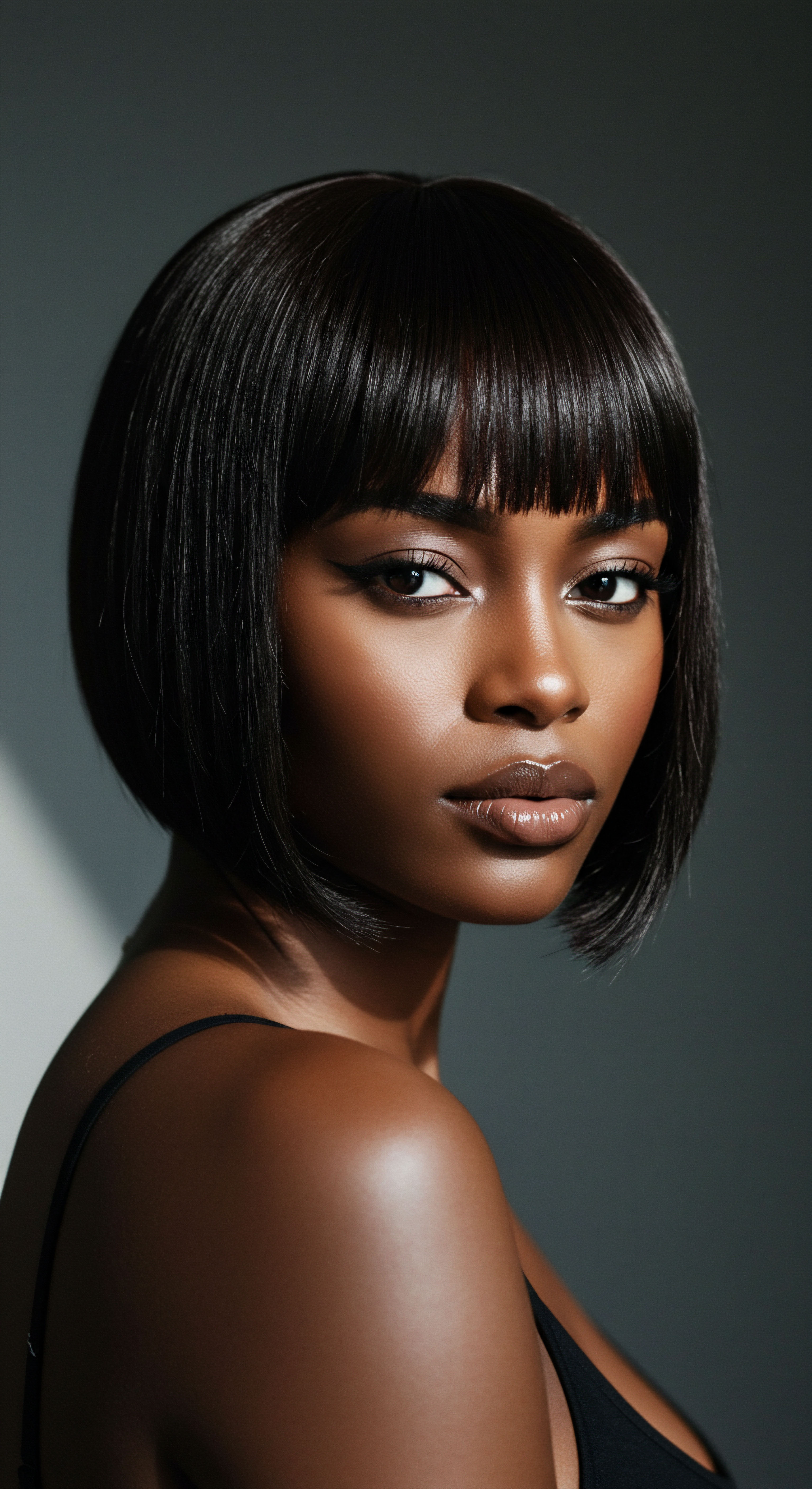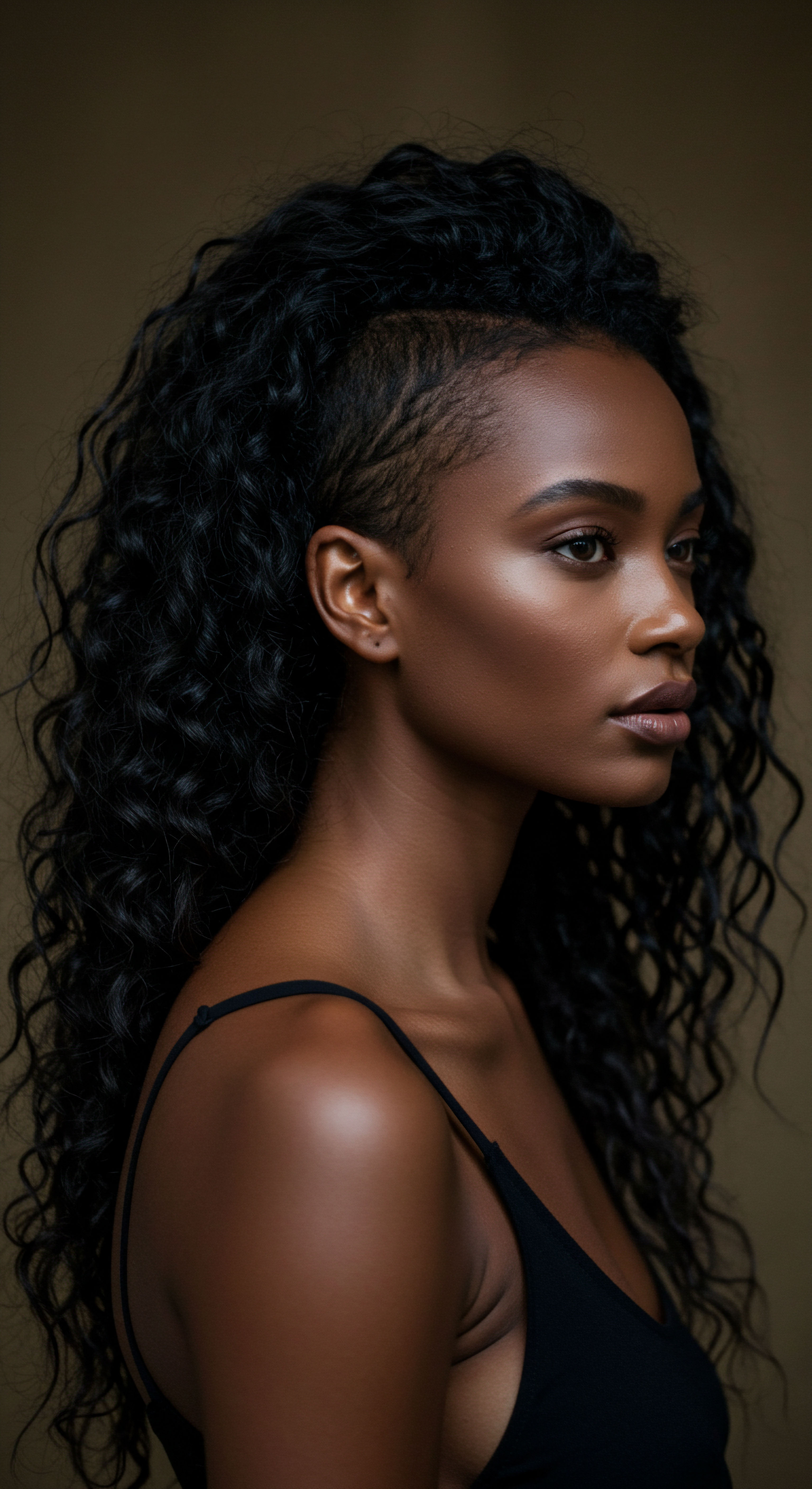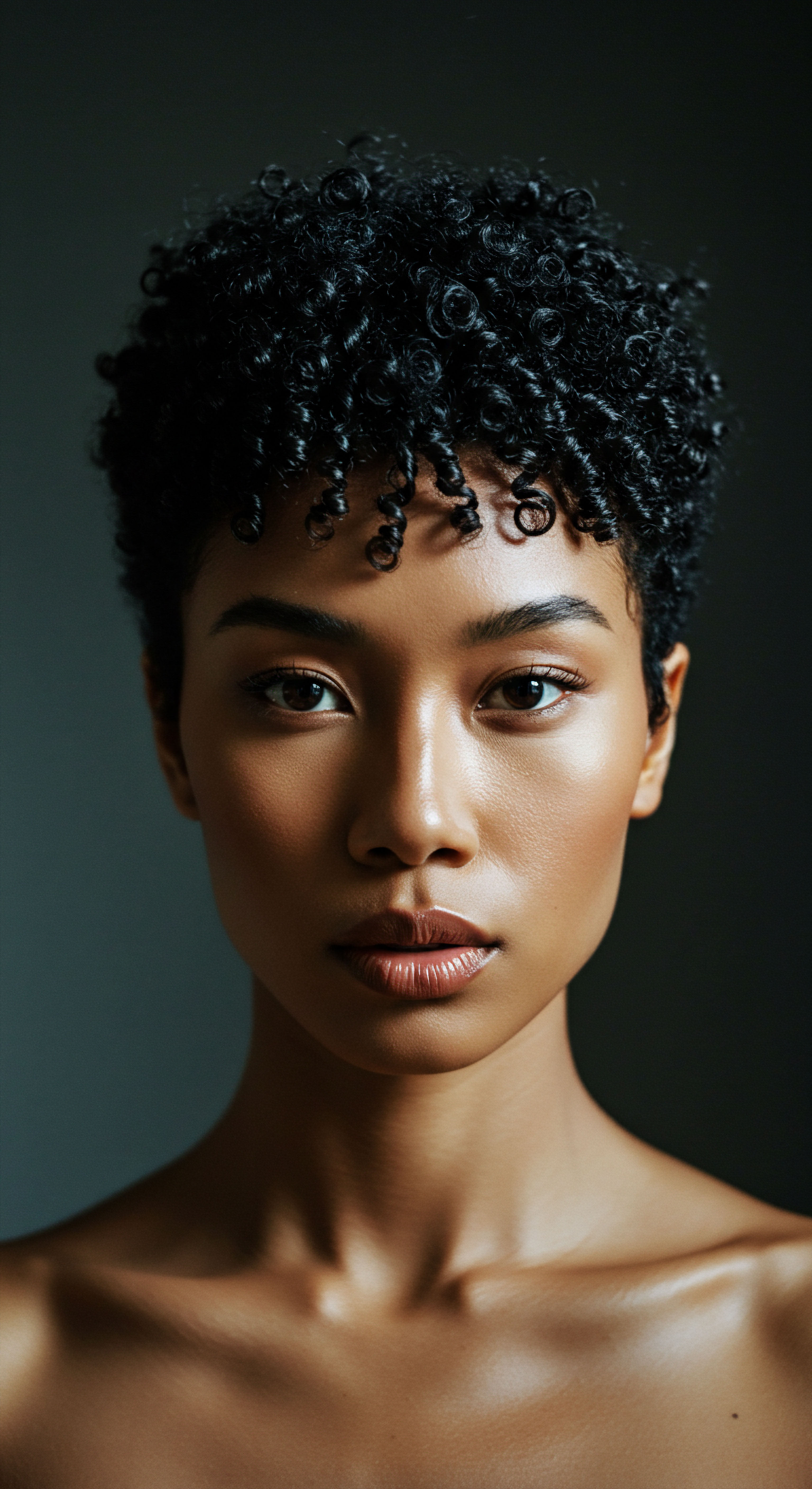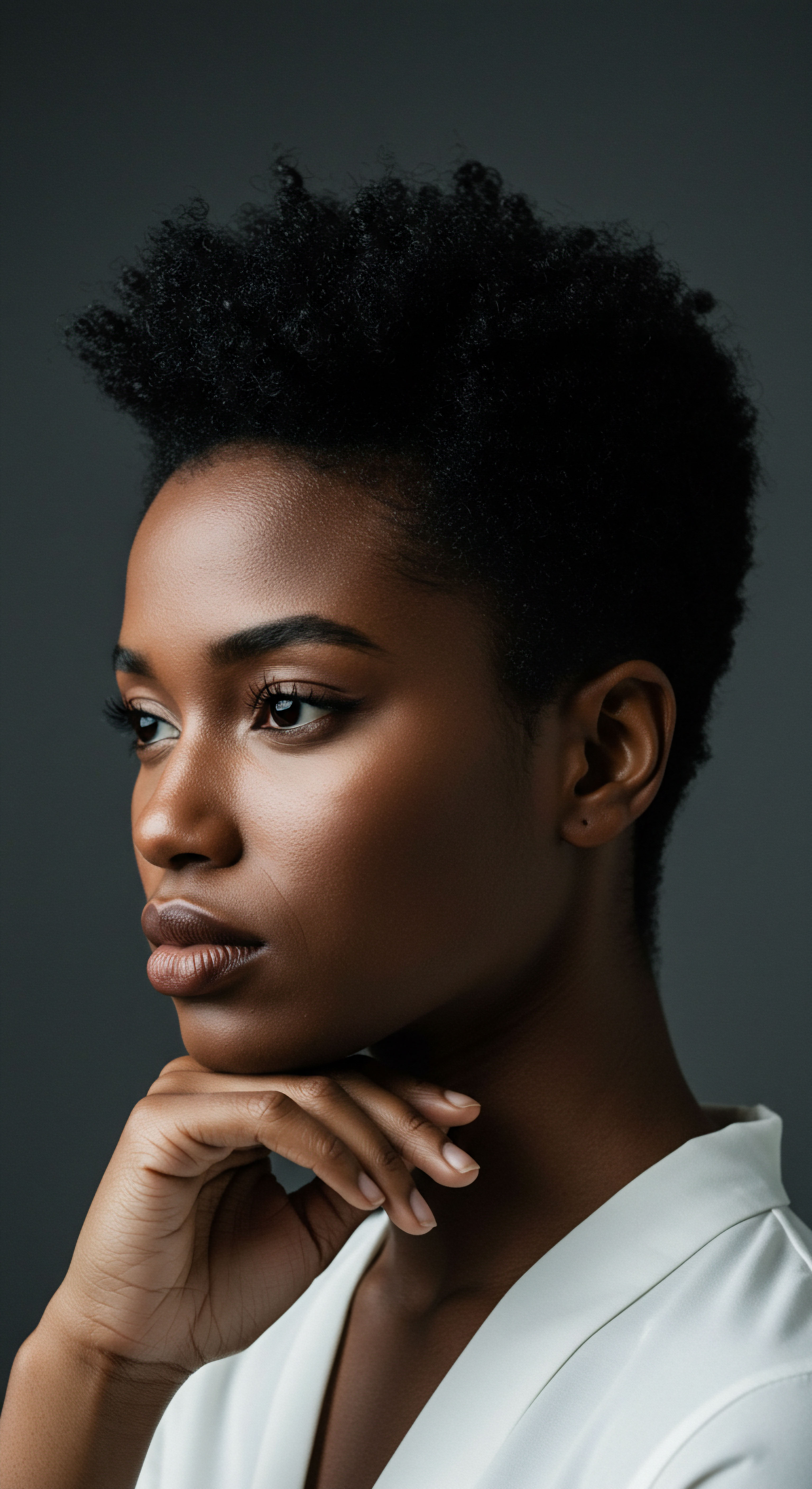
Roots
The quiet rhythm of our existence, often taken for granted, plays a subtle yet profound role in the vitality of our textured strands. Beneath the surface, within the very fabric of our being, a silent symphony of cellular processes unfolds each day and night. For those with coils, curls, and waves, this unseen dance holds particular significance, dictating not only the appearance of our hair but its very ability to flourish. We often speak of moisture, of styling techniques, of the perfect product blend, yet rarely do we turn our gaze inward, towards the foundational, almost elemental forces that govern hair’s inherent strength and potential.
The foundational strength and potential of textured hair are intrinsically linked to the unseen, elemental forces within our bodies, particularly during periods of rest.
Consider the intricate network that constructs each strand. Hair, far from being a mere aesthetic adornment, serves as a remarkable biological extension of our skin. At its base lies the Hair Follicle, a complex mini-organ residing within the dermis. This follicle acts as a tiny factory, perpetually constructing the keratinized protein filaments we know as hair.
For textured hair, the follicle’s unique curvature dictates the curl pattern, influencing everything from the shape of the strand to its propensity for tangling and its ability to retain moisture. Understanding this microscopic architecture provides a clearer lens through which to view the impact of systemic influences, such as the quality of our sleep.

Hair Anatomy and Physiology Specific to Textured Hair
Textured hair possesses distinct anatomical features that influence its growth and maintenance. The follicle itself is often curved or spiral-shaped, which causes the hair shaft to grow in a helical or coiled manner. This curvature leads to an uneven distribution of keratinocytes, the cells that produce keratin, resulting in a strand that varies in thickness along its length.
The cuticle, the outermost protective layer of the hair, tends to be more lifted or open in textured hair, which, while allowing for greater product penetration, also makes it more susceptible to moisture loss and environmental damage. The cortex, the inner layer providing strength and elasticity, is often denser in certain areas, contributing to the hair’s characteristic spring.
These structural differences mean textured hair often requires specific considerations in its care. The natural bends and twists along the hair shaft create points of weakness where breakage can occur, particularly when subjected to friction or manipulation. The more open cuticle, while allowing for hydration, also permits water to escape more readily, making dryness a common concern. Thus, any systemic factor that influences the integrity of the hair-producing cells or the environment within the follicle can have a pronounced effect on the hair’s overall well-being.

Hair Growth Cycles and Influencing Factors
Hair growth follows a cyclical pattern, a biological rhythm inherent to all mammals. This cycle consists of three primary phases:
- Anagen ❉ This is the active growth phase, where hair cells rapidly divide, pushing the hair shaft outwards. For scalp hair, this phase can last anywhere from two to seven years, determining the maximum length a person’s hair can achieve. During this time, the follicle is highly metabolically active, requiring a steady supply of nutrients and energy.
- Catagen ❉ A transitional phase, lasting about two to three weeks. During this brief period, the hair follicle shrinks, detaches from the dermal papilla (which supplies blood and nutrients), and hair growth ceases.
- Telogen ❉ The resting phase, typically lasting around three months. The old hair remains in the follicle, but it is no longer growing. At the end of this phase, the old hair sheds, and a new anagen hair begins to grow in its place.
Numerous factors can influence the duration and health of these cycles, including genetics, nutrition, hormonal balance, and systemic health. Disruptions to any of these can prematurely shorten the anagen phase or push a higher percentage of hairs into the resting or shedding phases, leading to noticeable thinning or reduced growth. The intricate interplay of these internal systems means that even seemingly unrelated aspects of our well-being can directly shape the narrative of our hair.

Cellular Regeneration and Hair Follicle Health
At the heart of hair growth lies the constant process of cellular regeneration. Within the hair follicle, specialized stem cells continuously divide and differentiate, giving rise to the various cell types that form the hair shaft. This process is energetically demanding and highly regulated, relying on precise signaling pathways and an optimal microenvironment within the follicle. The dermal papilla, a cluster of cells at the base of the follicle, plays a critical role in this regulation, providing growth factors and nutrients that sustain the proliferative activity of the matrix cells responsible for hair production.
The body’s repair and regeneration mechanisms are not constant throughout the day; they operate on a circadian rhythm. Many cellular repair processes, including DNA repair and protein synthesis, are most active during periods of rest, particularly during deep sleep. When sleep quality is compromised, these restorative processes can be hindered, potentially impacting the ability of hair follicle stem cells to perform optimally. This suggests a direct link between the body’s overall regenerative capacity, significantly influenced by sleep, and the sustained health and activity of the hair follicles.

Ritual
Moving beyond the fundamental biological underpinnings, we arrive at the practical wisdom that guides our daily existence. Our rituals, particularly those enacted as daylight fades, hold a quiet power over the tangible reality of our textured hair. We seek ways to preserve its delicate structure, to shield it from the wear and tear of the world, and to prepare it for the renewal that comes with rest. This transition from active engagement to passive restoration is where the often-overlooked influence of sleep truly asserts itself, not just as a biological necessity, but as a crucial component of our hair care regimen.
Our evening practices, especially those surrounding sleep, significantly determine the tangible health and preservation of our textured hair.
The nightly hours, far from being a period of inactivity, are a time of subtle yet profound transformation for our hair. It is during this time that friction against rough surfaces can lead to breakage, moisture can be wicked away, and delicate curl patterns can be disrupted. Acknowledging this vulnerability invites us to adopt mindful practices that safeguard our strands, turning the simple act of going to sleep into a protective ritual.

The Nighttime Sanctuary Essential Sleep Protection
Creating a sanctuary for our hair at night involves conscious choices about how we prepare our strands for rest. The primary goal is to minimize friction and moisture loss.
- Silk or Satin Pillowcases ❉ Unlike cotton, which has a rougher surface that can snag hair and absorb its natural oils, silk and satin provide a smooth, low-friction surface. This allows hair to glide rather than rub, significantly reducing mechanical stress, frizz, and breakage.
- Bonnets and Scarves ❉ Wrapping textured hair in a silk or satin bonnet or scarf offers an additional layer of protection. It keeps strands contained, preventing them from rubbing against pillows or becoming tangled during movement. This containment also helps to seal in moisture from nighttime products, allowing them to work more effectively.
- Protective Styling for Sleep ❉ Before bed, opting for loose protective styles such as a pineapple, braids, or twists can further safeguard hair. These styles keep strands organized, minimize tangling, and reduce the surface area exposed to friction. The key is to ensure these styles are not too tight, as excessive tension can lead to traction alopecia.
These practices are not merely about preventing immediate damage; they are about supporting the hair’s long-term vitality by reducing cumulative stress. Each night of mindful protection contributes to stronger, healthier strands over time.

Physical Stressors During Sleep
The seemingly innocuous act of sleeping can present several physical challenges to textured hair.
- Friction ❉ As we shift and turn during sleep, our hair rubs against bedding. Cotton pillowcases, with their absorbent fibers, create significant friction, leading to lifted cuticles, frizz, and eventually breakage. This is particularly detrimental to textured hair, which already has a more open cuticle structure.
- Tangles ❉ Unprotected hair can become easily tangled during sleep, especially if it is long or prone to knotting. Attempting to detangle severely matted hair in the morning often results in significant breakage and discomfort.
- Moisture Loss ❉ Cotton is highly absorbent and can wick away moisture from hair, leaving it dry and brittle by morning. This exacerbates the natural tendency of textured hair towards dryness, making it more vulnerable to damage.
Addressing these physical stressors through protective measures creates an environment where hair can rest and recover, rather than endure further strain.

Hormonal Rhythms and Hair
Beyond the physical, the body’s internal rhythms, profoundly shaped by sleep, hold sway over hair vitality. Hormones, those silent messengers, regulate countless bodily functions, including the hair growth cycle. Melatonin, often associated with sleep regulation, has been found to play a more direct role in hair follicle activity.
Research, such as a study published in the Journal of Pineal Research, indicates that Melatonin can influence the hair growth cycle by stimulating the anagen phase and delaying the catagen phase, thereby extending the period of active growth. When sleep patterns are erratic, the body’s natural melatonin production can be disrupted, potentially diminishing this beneficial effect on hair follicles.
Furthermore, the stress hormone Cortisol also follows a circadian rhythm, typically peaking in the morning and declining at night. Chronic sleep deprivation can elevate evening cortisol levels, maintaining the body in a state of heightened alert. Sustained high cortisol levels have been linked to hair cycle disruption, potentially pushing more hair into the resting (telogen) phase prematurely, leading to increased shedding. Thus, the quality of our rest directly influences the hormonal landscape that nurtures or challenges our hair.
| Hormone Melatonin |
| Primary Function Related to Sleep Regulates sleep-wake cycles, antioxidant |
| Impact on Hair Follicle Activity May prolong anagen phase, promote hair growth, and protect follicles from oxidative stress. Disrupted sleep can lower production. |
| Hormone Growth Hormone |
| Primary Function Related to Sleep Tissue repair, cell regeneration, muscle growth |
| Impact on Hair Follicle Activity Peaks during deep sleep; essential for cellular repair and renewal, including hair follicle stem cell activity. Insufficient deep sleep reduces output. |
| Hormone Cortisol |
| Primary Function Related to Sleep Stress response, regulates metabolism |
| Impact on Hair Follicle Activity Elevated by sleep deprivation; chronic high levels can disrupt hair cycle, potentially leading to premature telogen entry. |

Relay
How does the silent world of our sleep, with its intricate dance of cellular repair and hormonal ebb and flow, truly connect with the vibrant, textured hair we carry? This question invites us to peer beyond the immediate and into the profound, recognizing that the vitality of our strands is not an isolated phenomenon but a sensitive barometer of our holistic well-being. It asks us to consider the less obvious pathways, the deep, interconnected systems that relay signals from our internal state to the very tips of our curls.
The vitality of our textured hair acts as a sensitive indicator of our holistic well-being, reflecting deep, interconnected systemic signals.
The concept of a “relay” speaks to the intricate chain reactions within the body, where one process influences the next, creating a cascade of effects. Sleep, as a fundamental pillar of health, initiates many of these cascades. Its influence extends far beyond merely feeling rested, permeating the complex biological machinery that supports hair growth and resilience. To truly grasp the impact of sleep on textured hair, we must venture into the realm where biology, psychology, and even cultural understanding converge.

The Neuro-Endocrine-Immune Axis and Hair
Our bodies operate as highly interconnected systems, none more so than the neuro-endocrine-immune (NEI) axis. This complex communication network links the nervous system, the endocrine (hormonal) system, and the immune system. Sleep plays a critical role in maintaining the delicate balance of this axis. Poor sleep can disrupt the NEI axis, leading to systemic inflammation, altered hormone production, and a weakened immune response.
For hair follicles, this disruption can be significant. Hair follicles are not isolated; they are highly vascularized and innervated, meaning they receive signals from both the nervous and circulatory systems. Inflammation within the body can negatively impact the follicular microenvironment, potentially leading to miniaturization or premature shedding.
Furthermore, an imbalanced immune response can trigger autoimmune conditions that target hair follicles, such as alopecia areata. The harmony of the NEI axis, greatly influenced by consistent, restorative sleep, provides a crucial foundation for sustained hair vitality.

Sleep Disorders and Hair Thinning
The connection between sleep and hair moves from subtle influence to more direct correlation when sleep disorders are present. Conditions like chronic insomnia, sleep apnea, and restless legs syndrome significantly disrupt the body’s natural restorative processes.
- Chronic Insomnia ❉ Persistent difficulty falling or staying asleep leads to chronic sleep deprivation. This can elevate stress hormones like cortisol, which, as previously discussed, can disrupt the hair growth cycle. The ongoing physiological stress also contributes to oxidative stress and inflammation, both detrimental to hair follicle health.
- Sleep Apnea ❉ Characterized by repeated interruptions in breathing during sleep, sleep apnea leads to intermittent hypoxia (low oxygen levels). Oxygen is vital for cellular function, including the high metabolic activity of hair follicles. Chronic oxygen deprivation can impair the ability of follicles to produce healthy hair, potentially leading to thinning or shedding.
- Restless Legs Syndrome ❉ While less directly linked, the constant movement and disrupted sleep associated with RLS can contribute to overall sleep deficit and increased physical stress, indirectly affecting hair health.
A compelling discovery reveals that hair follicles possess their own internal circadian clocks, orchestrating cycles of growth and rest independently, yet still attuned to the body’s grander daily rhythms. Research, such as the work published in Nature by Plikus and colleagues in 2017, demonstrates how these intrinsic follicular oscillators govern processes vital to hair vitality, including cell proliferation and pigment production. When the body’s central clock, regulated by our sleep-wake cycle, falls out of sync due to restless nights, it can send disorienting signals to these delicate follicular timekeepers, potentially disturbing the hair’s natural progression through its growth phases. This intricate interplay underscores the deep connection between our sleep rhythms and the very timing of our hair’s existence.

Cultural Perspectives on Rest and Beauty
Across various cultures, the concept of rest is often intertwined with beauty and well-being. Traditional practices and ancient wisdom frequently acknowledge the restorative power of sleep, not just for physical recovery but for maintaining a vibrant appearance, including hair. In many indigenous cultures, nighttime rituals, often involving oils, gentle styling, and specific coverings, are passed down through generations. These practices are not solely about product application; they carry a deeper significance of preparing the body and spirit for rest, recognizing the profound link between inner harmony and outer radiance.
For example, in some African and Afro-diasporic traditions, the practice of oiling the scalp and hair before bed, followed by protective wrapping, was not merely a cosmetic act. It was a holistic ritual that honored the hair as a conduit of spiritual and physical strength, recognizing that its vitality was intrinsically linked to the body’s regenerative processes during sleep. This perspective highlights a long-held understanding that true beauty springs from a place of internal balance and restorative practices, underscoring the deep-seated cultural acknowledgment of sleep’s role in hair health.

Nutritional Support and Sleep for Hair
The nourishment our hair receives is a direct reflection of our dietary intake, but the utilization of these nutrients is optimized during sleep. During deep sleep, the body prioritizes repair and synthesis, efficiently allocating resources to processes like protein synthesis and cellular regeneration. Essential nutrients for hair growth, such as proteins (keratin’s building blocks), iron, zinc, biotin, and vitamins A, C, and E, are more effectively processed and distributed when the body is in a restorative state.
Conversely, chronic sleep deprivation can impair nutrient absorption and increase metabolic stress, potentially diverting these vital resources away from non-essential functions like hair growth. This creates a cycle where poor sleep can lead to nutrient deficiencies for hair, even with an adequate diet, further compromising its strength and growth potential.
| Nutrient Protein (Amino Acids) |
| Role in Hair Health Building blocks of keratin, hair structure |
| Connection to Sleep/Restoration Protein synthesis and repair processes are optimized during deep sleep. |
| Nutrient Iron |
| Role in Hair Health Oxygen transport to follicles |
| Connection to Sleep/Restoration Energy metabolism and cellular respiration, which are vital for active hair growth, are supported by adequate rest. |
| Nutrient Zinc |
| Role in Hair Health Cell division, protein synthesis, oil gland function |
| Connection to Sleep/Restoration Supports immune function and cellular repair, both enhanced during restorative sleep. |
| Nutrient Biotin (Vitamin B7) |
| Role in Hair Health Keratin production, fatty acid synthesis |
| Connection to Sleep/Restoration B vitamins play roles in energy metabolism; efficient utilization is linked to overall bodily function, including rest. |
| Nutrient Vitamin D |
| Role in Hair Health Hair follicle cycling, immune regulation |
| Connection to Sleep/Restoration Immune system regulation and cellular differentiation, processes that benefit from proper sleep. |

Reflection
The delicate dance between our nightly repose and the vibrant life of our textured hair is a testament to the profound interconnectedness of our being. It reveals that true hair vitality extends beyond the topical, reaching into the very core of our physiological rhythms. When we honor the quiet call for rest, providing our bodies with the deep, restorative sleep they require, we are not merely recovering from the day; we are actively cultivating the conditions for our strands to flourish, inviting a quiet strength and serene radiance to unfold. This understanding transforms sleep from a simple habit into a conscious act of profound self-care, a silent promise to the inherent beauty of our textured crowns.

References
- Fischer, T. W. Slominski, A. Tobin, D. J. Paus, R. & Slominski, A. T. (2014). Melatonin Regulates the Human Hair Follicle Cycle. Journal of Pineal Research, 57(3), 329–338.
- Plikus, E. V. Gay, D. L. Treffeisen, E. Sundberg, J. P. Quigley, I. Lim, C. H. & Cotsarelis, G. (2017). The Hair Follicle as a Circadian Clock. Nature, 544(7648), 108–112.
- Trüeb, R. M. (2009). Oxidative Stress and Hair. International Journal of Trichology, 1(1), 6–10.
- Paus, R. & Cotsarelis, G. (2007). The Biology of Hair Follicles. The New England Journal of Medicine, 357(11), 1098–1107.
- O’Leary, S. J. & Cotsarelis, G. (2018). The Hair Follicle ❉ A Stem Cell Niche for Life. Current Opinion in Cell Biology, 54, 99–106.
- Oh, S. Y. Lee, J. S. Lee, K. S. Kim, H. S. & Kim, H. Y. (2019). Sleep Quality and Hair Loss ❉ A Cross-Sectional Study. Journal of Cosmetic Dermatology, 18(6), 1845-1850.
- Slominski, A. Wortsman, J. Tobin, D. J. Zmijewski, M. Pisarchik, A. Semak, I. & Slominski, A. T. (2005). The hair follicle as a peripheral neuroendocrine organ. Journal of Investigative Dermatology, 124(2), 297-302.